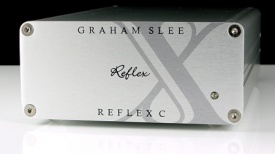
Rega Aura Reference Moving Coil Phono Stage
- Please note: this product cannot be sold online, please call to order over the phone and collect from our showroom. Otherwise, feel free to book a demonstration.
'The Reg Aura is clearly a top notch phono preamplifier, its build quality, range of features and sheer transparency put it in the premier league. There’s no shortage of competition at and above this price point but you don’t often get the combination of qualities that the Aura offers, and as these results show this is not exclusive to Rega cartridges by any means. So if you are looking to go deep into your vinyl grooves and have a turntable, arm and cartridge that can dig out the details in a shining and beautiful manner then the Aura is definitely a contender for your budget.'
Jason Kennedy, the-ear.net
The reference Aura MC stage is the culmination of decades of electronic design development. We have created the ultimate, fully adjustable, three stage, all symmetrical pre-amplifier designed purely to extract the very best performance from your moving coil cartridge and vinyl playback system.
Built into a completely re-designed custom case, the Aura is dedicated to moving coil cartridges and stays clear of any compromises. We have avoided including any superfluous functions as they obstruct the signal path and degrade the sound quality. The Aura phono pre-amp incorporates remarkable and innovative design ideas. If you are a vinyl connoisseur, then the Aura MC is an absolute must for demonstration.

Introduction and Design Innovation
The Rega Aura is a three stage, all symmetrical pre-amplifier. The first stage is a symmetrical, complementary class A amplifier, using parallel connected Linear Systems ultra-low noise FET (Field Effect Transistor) transistors configured as a symmetrical compound pair input stage. The use of FET transistors ensures there is no bias current flowing in the cartridge coil so as not to upset the delicate magnetic geometry of the cartridge. The input circuit configuration also alleviates the use of any coupling components between the cartridge output and the input stage FET transistors, which would degrade the sound. The complementary ultra-low noise FET transistors are carefully graded and matched for optimum performance. This stage drives the passive high frequency part of the RIAA equalisation stage.
The second stage is a symmetrical, class A, differential amplifier with a common base driver stage; this is also used as the active amplifier in the low frequency part of the RIAA equalisation stage. The third stage inverts the signal to provide the balanced output along with the output of the second stage; the third stage uses the same circuit topology as used in the second stage. The power supply is a symmetrical, discrete tracking power supply using fast diodes and a low noise voltage reference. Each stage has its own localised power supply and LED referenced current generators. To maximise headroom, the Aura has a power supply voltage, which is 60% higher than normally found in such a pre-amplifier. Very high quality, polypropylene capacitors have been used in the signal path. 1% tolerance polypropylene capacitors are used in the RIAA EQ stages and audio grade capacitors are used in the rest of the circuit. Gain, Mute and Mono switching is implemented using high quality relays.
Gain
Please note: mute or turn the volume control to minimum when changing the gain setting. The gain setting switch selects the voltage gain of the phono amplifier. Gain I selects 69.5 dB (switch out) and Gain II selects 63.5 dB (switch in); this will provide an input sensitivity of 67 μV and 131 μV respectively for an output level of 200 mV unbalanced and 400 mV balanced. The balanced output is effectively 6 dB higher than the unbalanced output. It is advisable to start with the lower gain setting II and if necessary, increase the gain level to I if more level is required for lower output cartridges. Because the balanced output is effectively 6 dB higher, it could be advisable to select gain II setting when using the balanced output; this will also depend greatly on the sensitivity of the connected amplifier.
Capacitance
There are five different input capacitance settings of 1000 pF, 2000 pF, 3200 pF, 4300 pF & 5700 pF. Select the required capacitance to match to that specified by the manufacturer in the cartridge specifications. It is permissible to try different loading conditions as sometimes changing the capacitance gives a different sonic performance more suited to your personal taste; this also applies if there is no loading capacitance specified by the manufacturer. To match some ‘legacy’ pre-amplifiers, select 5700 pF. The 1000 pF setting is optimised for the Rega range of MC cartridges.
Load Settings
There are five different input load settings of 50 Ω, 100 Ω, 150 Ω, 300 Ω & 400 Ω. Select the required load to match to that specified by the manufacturer in the cartridge specifications. It is permissible to try different loading conditions as sometimes changing the load gives a different sonic performance more suited to your personal taste. To match some ‘legacy’ pre-amplifiers, select 400 Ω. The 100 Ω setting is optimised for the Rega range of MC cartridges.
Mute
Allows you to mute the signal when changing the gain setting, in-between tracks or when changing records.
Mono
This function allows you to play mono recordings via a stereo cartridge.


.jpg)
.jpg)







